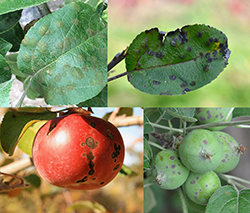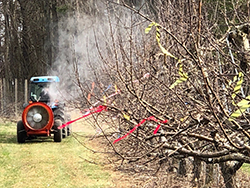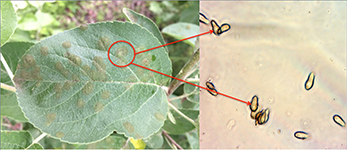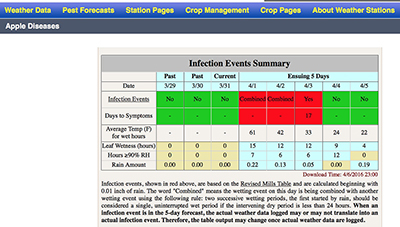INTRODUCTION
A young apple grower, Laura Sagar, has adopted new cultural control (these include non-chemical means of reducing pest pressure, such as removing infected leaves or using disease resistant varieties) strategies to reduce the risk of scab, and weather-based disease models to forecast the risk of scab infections. In the past, Laura’s father had sprayed according to how long it had been since his last fungicide application, usually every five to seven days from early spring into early summer. Now, however, Laura, as well as her customers, want to keep fungicide use at a minimum. Cultural controls and disease forecasts offer ways to reduce the threat of scab outbreaks and the need for fungicide sprays while maintaining crop quality. The combination worked well in Laura’s first years managing the orchard, but then a devastating scab epidemic nearly destroyed her crop, causing her to ask whether she should return to her father’s calendar-based approach to scab management.
The apple scab management failure case asks students to learn the biology of apple scab, and to understand how knowledge of the epidemiology of scab has been used to design integrated pest management (IPM) approaches for scab. By determining how the scab epidemic in Laura Sagar’s orchard happened, students will learn about effective ecologically based tactics for managing plant diseases, such as physically decreasing pest populations, monitoring weather, and using disease risk forecasts.
OBJECTIVES
The goal of this case study is to teach students modern methods for plant disease management by asking them to determine the reasons behind the failure of a management program. Students will learn the basics of two empirical disease forecast models, the importance of weather in such forecasts, and how they are used in an IPM program. The case study will also show that real IPM involves more than fungicide management.
After completing this case study, the student will:
- Recognize apple scab symptoms.
- Understand the apple scab disease cycle and the role played by weather in scab infections.
- Understand the importance of primary inoculum and managing primary infections in a polycyclic disease.
- Be able to weigh the advantages and limitations of timing fungicide applications using weather forecasts and related models.
CAST OF CHARACTERS
Laura Sagar – Apple orchard owner/manager. She inherited the orchard from her family.
Noah Elma - Extension fruit specialist in western Massachusetts, working to get fruit growers to use IPM, particularly cultural controls and disease forecasting models, in order to reduce pesticide use while maintaining crop quality.
Jennifer Shea – Plant pathologist.
THE CASE
Laura Sagar had been learning the ropes of managing her family’s apple orchard from her father from the time she was a small child through high school and college, and since graduating she had been anxiously waiting to run the orchard herself. In 2009, when her father Jerry reached his 65th birthday, he sold the Sagar Family Orchard to her, and left the Massachusetts farm for Aruba. Laura had the independence she’d long wanted, but for the first time felt the full worry and stress of making her living from the farm.
 |
Figure 1. New apple scab infections on an apple
leaf early in the season (top left); older leaf infections
that have darkened (top right); lesions on young fruit
(bottom right) and scabbed fruit at harvest (bottom left). |
High among those worries was managing apple diseases. Apples in Massachusetts get many diseases, most caused by fungi; the most important of these is apple scab (Figure 1). The apple varieties McIntosh and Cortland, preferred by Laura’s customers, are especially susceptible to scab. In Massachusetts, a normal spring is rainy and cool, providing the perfect conditions for apple scab infections. If apple growers fail to manage the disease, scab can be devastating, destroying most or all of a crop. Laura’s father, like many conservative, older growers, had managed scab using frequent applications of fungicides, which are chemicals that can kill the pathogen that causes scab, the fungus
Venturia inaequalis. To do this, he used a huge airblast sprayer (Figure 2), a machine that sprayed a mist of pesticides into a fan the size of a small plane’s propeller, driving clouds of fungicide solution onto the trees. His strategy was simple: keep the trees covered with fungicide from the time the first green leaflets emerged in spring until after trees had bloomed and fruit had set. Usually, he had to apply fungicide sprays targeting scab about ten times each year, sometimes more. Even then, occasionally there would be apples with scab at harvest, and every scabby apple was a worthless apple.
 |
Figure 2.
Airblast sprayer applying pesticides
in an applied research apple orchard. |
Laura didn’t really enjoy driving the tractor up and down the rows, often in the night, with the roaring sprayer at her back, but there was really no alternative if she wanted to stop scab and other disease and insect problems. She knew her customers, and consumers in general, worried about pesticides on fruit. So when Laura heard about a way to cut sprays without increasing the risk of pest damage, it caught her interest. The approach, Integrated Pest Management or IPM, decreased reliance on pesticides, and incorporated other tactics to manage diseases and insects effectively. It meant spending more time every day gathering information about the insects and diseases, but she hoped it would reduce the time and money she spent spraying. Over the three years she had been using IPM, it had lived up to its promise.
 |
|
Figure 3.
Apple scab disease cycle. |
IPM programs require that a grower understand the biology of the pest to be managed - in this case, the fungus
Venturia inaequalis and its disease cycle (
Figure 3). Laura had learned that scab epidemics happen in two phases, primary infections and secondary infections. Primary infections start an epidemic, and are caused by the apple scab fungus, which survives winter in old leaves on the orchard floor (
Figure 4). Usually, the first spores are ready to be released just as apple trees emerge from dormancy in the spring, pushing out new green leaves (
Figure 5). Wet weather is critical to the development and release of these fungal spores, called ascospores (
Figure 6), which float into the air. Spores that land on the new apple leaves germinate, producing a small tube called a hypha (
Figure 7). If the leaf stays wet for long enough, the tube penetrates the leaf’s cuticle. Once inside, the fungus continues to grow along the leaf surface, between the cuticle and epidermis. Eventually the fungus shoves its way back out through the cuticle, forming a fuzzy mat containing tens of thousands of new spores (
Figure 8). These spores, called conidia, can each start new, infections, termed secondary infections, which in turn can produce another generation of conidia, and in a few weeks, a scab epidemic can explode.
 |
 |
Figure 4.
Right: apple leaf from an orchard floor showing
scab infections from the previous growing season (dark areas).
Left: magnified scab lesion in a leaf showing several fruiting
bodies (round, dark objects), called pseudothecia, with
one pseudothecium circled. |
Figure 5.
The green tip
growth stage on apple,
when buds break and begin
to form the first leaves.
|
The amount of time it takes a scab infection to go from penetrating a leaf to producing conidia depends on temperature. At relatively warm temperatures, for example 65 to 75º F, it takes nine days; when it’s cold, say 45 to 55ºF, it takes 17 days. Before the new scab spots become visible, growers can’t see the fungus growing. It’s invisible. They have to depend on understanding the conditions that lead to infection in order to make good management decisions.
Laura knew the key to apple scab IPM is preventing primary infections. “If primary scab infections are prevented, or reduced,” the IPM specialist had explained, “there is no need to spray for secondary scab infections. There’s no inoculum.”
 |
 |
Figure 6.
Venturia inaequalis pseudothecium
magnified under a microscope (400X) in a
prepared “squash mount” showing the three
important stages of ascospore maturation:
immature asci with no spores or immature
spores; a mature ascus with mature
ascospores; and an empty ascus, which has
discharged spores. |
Figure 7.
Venturia inaequalis
ascospore germinating,
producing hyphae which
can penetrate apple tissue.
|
 |
Figure 8.
New scab lesions on a leaf (left) conidia that have developed
as a result of infection (right). |
The apple IPM program involved collecting a lot of information. For apple scab, Laura started by estimating how much inoculum would be in the orchard at the beginning of the season. This meant going through the orchard after harvest in the fall and systematically counting the number of infected leaves on a sample of trees after harvest. It took time when she was already quite busy selling apples, but it gave her a clear indication of the relative risk of scab for the following season. Ascospores from
V. inaequalis usually don’t travel very far, about 100 feet or so. That means most, if not all, of the inoculum comes from leaves that fall within an orchard, rather than from orchards down the road or elsewhere. If there are very few scab-infected leaves at harvest, the risk of scab next year is low. Better yet, the risk of scab infections when leaves first emerged in spring can be so low that there’s no need to spray as soon as the first green apple tissue emerges, so the first fungicide application, or even two, that her father had always made could be skipped. On the other hand, if Laura found enough scab-infected leaves, she knew she should start scab management as soon as the first leaves emerged.
The next part of her IPM program involved
sanitation, which meant destroying as much potential primary inoculum (in the infected leaves) in the orchard as she could. To do this, Laura would spray the trees with a common nitrogen compound, urea, just before the leaves fell. If she was too busy, she could spray urea on the fallen leaves, either in the fall or the spring. After that, she would use a kind of mowing machine called a flail chopper to grind the leaves to bits. The nitrogen in the urea fed bacteria and other microbes that would quickly decay the leaves, while chopping further promoted leaf decay and disrupted fungal growth. It was a kind of insurance against inoculum that might be in the old leaves.
In spring, when the apples began to break buds, Laura kept careful track of the weather. Weather, especially temperature and moisture, is an important part of any pest’s development. She had purchased an electronic weather station that fed data into her office computer, then over the Internet to a computer at a university, where it was run through different
pest forecasting models. Laura could use a web app to look at the output. This app told her whether an infection had occurred, and using data from weather forecasts, whether an infection might be coming. All of the calculations happened virtually instantaneously. Using the information, Laura could decide whether she needed to spray. Basically, the app told her when the scab fungus was producing ascospores and when it stopped making them (Figure 9), and if rainy weather might lead to a scab infection (Figure 10). Laura didn’t understand the details of the models in the app, but they had worked well for her so far.
 |
Figure 9. Output from a decision support system (Network for the
Environment and Weather Applications, NEWA, an online tool that
includes pest forecasting models) for apple scab indicating estimated
ascospore maturation. At this site during this year, accumulated
ascospore maturity reached an estimated 95% on May 2 and an
estimated 100% on May 15. |
 |
Figure 10. Output from a decision support system (NEWA) for
apple scab indicating infection events from Mar. 29 to 30, and
forecast to Apr. 5, indicating a high risk of infection on Apr. 1 to 3,
with relevant related data and forecasts. |
She did know that whether ascospores cause primary infections depends on wet leaves, so growers need to keep a close eye on “wetting periods” and their associated temperatures. Not all wetting periods cause infection. Wet periods that can cause infections are known as infection periods, or
Mills Periods, after a scientist who discovered that the time needed for infection varies with temperature. At cold temperatures, near freezing, it takes as long as two days for the scab spores to germinate and infect wet leaves. At warmer temperatures, around 60 to 75 ºF, it takes only nine hours of leaf wetting for the fungus to infect. If a weather forecast predicted infection conditions, it would show up on the app, and Laura would apply fungicide protection if she needed to. Alternatively, with some fungicides, it is possible to spray after an infection has started, and Laura would use these post-infection sprays if needed. In any case, she could use the app to overcome the invisibility problem with early scab infections, so she could tell here whether or not an infection had occurred.
In the fall of 2014, Laura found herself too busy with sales to spend time evaluating the amount of scab in her orchard. Recent springs had been very dry, and the orchard hadn’t had any significant scab for a couple of years. The search for one or two scab leaves in the orchard had gotten monotonous. She decided it would be okay to skip the inoculum monitoring that fall. And again, because she was busy, she decided to put off her sanitation treatment until spring.
The spring of 2015 began wet and muddy. Laura was a little nervous about not being able to get into the orchard to spray urea and chop leaves before the apple buds opened, but since she hadn’t had scab problems for several years, she didn’t think it would cause problems.
Buds swelled, burst open and started to produce flower buds; she watched the weather and the scab forecasts on her computer. As had become her practice in her low-inoculum orchard, she didn’t spray for the first infection period.
Then, abruptly, the rain disappeared, and a couple of days of hot dry weather dried the ground. A few days later, she put on a fungicide for scab when a cold front generated a couple of days of rain, enough for an infection according to the app forecast. After that, it stayed warm and dry for a couple of weeks.. When the petals began to fall from the apple flowers, petal fall, and the fruit begin to form, the rain returned for a week. Laura saw it coming using the app, and sprayed a fungicide to protect against infection. Normally, this would be the last primary scab spray Laura would need to apply that season. According to the app, ascospores had all matured. Primary scab was over. And this year looked more or less normal, if a little dry, the temperature-based model agreed with her father’s conventional wisdom, that inoculum had all been released a week after petal fall, and her fungicide protection should have dealt with the last infection. Laura heaved a mental sigh, deciding scab sprays were done. The bloom on her apples had been heavy, setting a good crop, and her harvest promised to be excellent.
Several weeks after the end of primary scab season, Laura was out checking for insect damage in the orchard, and was horrified to discover velvety, olive-colored spots on many of the leaves. This meant at least three, four or even more fungicide applications during late spring and summer would be needed to try to stop the epidemic from infecting fruit. Otherwise, come harvest, most of her apples would be unmarketable, and she would have a hard time making ends meet. Laura was angry and frustrated. She had followed the IPM strategy that had been working well for her for several years, yet the disease had hit her anyway. What had gone wrong???
Questions
- What is the most critical period in the apple growing season for scab management?
- What are two distinct stages in an apple scab epidemic, and what types of fungal spores are associated with each?
- What two environmental factors are critical in apple scab infections? Which one drives the development of primary inoculum? Which is/are important in an individual infection of apple tissue?
DISEASE MANAGEMENT
In a bit of a panic, Laura called her local Extension tree fruit specialist, Noah Elma, with whom she had worked to develop the IPM plan for her orchard, installing the weather station and getting connected with the university.
First, Noah grilled Laura on how much fungicide she applied in her sprays, whether she had calibrated her sprayer to apply correct amounts, and whether wind might have been blowing hard enough to cause the fungicide to drift away from the apple trees where it was needed. Laura kept detailed records of all her pesticide applications. These records include information like date and time of application, what materials and rates she used and a brief description of what the weather looked like for any given day. Based on Laura’s records, it didn’t appear as though wind or the amount of fungicide used were at fault.
Then they pored over the records from Laura’s weather station. There had been four infection periods during the time that models predicted ascospores were available to cause infections, two early and two late in the primary scab season. The pair then checked Laura’s fungicide spray records from that spring to verify that the orchard had been treated at the right times for each of the infection events.
“You didn’t put anything on for the first infection?” asked Noah.
“No. It was muddy in the orchard. And for the last few years, I’ve skipped the first one. No problem.”
“Let’s go look,” said Noah.
They went back to Laura’s orchard and pushed into the leaves on the trees to see exactly what the pattern of infection was. Right away, Noah saw that most infections were on leaves that had emerged relatively recently. In fact, some infections seemed to have happened after all inoculum should have been spent. It didn’t make sense, the model clearly showed primary scab inoculum depleted at least 10 days before some leaves had emerged and been hit with scab. Laura’s spray records indicated she had gotten a protective cover on in advance of each of the other primary infection events.
“Except for the first one”, observed Noah.
“I explained that. Shouldn’t have been a problem”, snapped Laura.
“What did your fall scab survey show?”
“Actually, I had to skip it last fall.”
“I’m thinking maybe that was a bad idea. You made a lot of assumptions.”
Noah’s idea was that Laura had been hit by a combination of failing to monitor and bad luck. Laura’s orchard had likely suffered a little more scab than usual the previous year, and she hadn’t noticed because she hadn’t done her usual careful fall evaluation. Normally, her sanitation program would have greatly reduced or eliminated most inoculum. But it hadn’t happened. But, where had the late season infections come from?
“Two possibilities,” said Noah. “You got some early infections in that first infection period, and it didn’t explode to the point you saw it until now. The other is a little strange. I’ve heard Jenn Shea say that the model for predicting the end of primary season may not be that accurate in dry years.”
Noah gave Jennifer Shea, a plant pathologist at the University of Massachusetts, a call. After hearing Laura’s tale of woe, Jennifer agreed. She had observed the actual growth and release of ascospores in order to check the model estimates. This year, the most commonly used model, the one Laura followed, had indicated primary season was done nearly two weeks before Jenn had stopped seeing mature spores. In that time, there had been a significant infection period. She had also fielded calls from other growers; Laura was not the only one with an apple scab outbreak, though hers was noticeably more severe.
The high number of infections in her orchard still surprised Laura. There shouldn’t have been much inoculum left at the end of ascospore development. Noah reminded her of the possibility of an infection very early in the season.
“The earlier scab starts, the worse the epidemic Laura. You know that.”
With more inoculum than usual in her orchard, any mistake would lead to more scab than usual. Some of the mistakes had been Laura’s. The fall assessment would’ve warned her of a potential problem.
Sanitation would have helped reduce the impact, had she done it. If she had checked her “hot spots”, the places where scab was most likely to hit, during the spring, she might have seen symptoms earlier and been better able to stop them.
“Yeah, I got kind of complacent. But what about the end of scab season thing?”
“I don’t know. Hopefully Jenn will fix that soon. Meanwhile, with these climate change extremes, dry then wet, I’d play it conservative. The decision support recommendations are a useful guide, but they aren’t absolute reality.”
It made sense, though it didn’t make Laura feel any better. It would be a rough year. She launched a fungicide program to kill off the scab infections and protect fruit from new, secondary infections. Ultimately, she sprayed twice as much as she normally had, and still suffered some loss from scab at harvest. It had cost her much more than usual. From then on, monitoring and the other IPM tactics she used for scab became a top priority: evaluating inoculum in the fall, spraying and chopped leaves in the fall, and interpreting the app recommendations more conservatively.
Questions
-
What are the three key factors that could have contributed to the scab epidemic in Laura’s orchard?
-
How does evaluating inoculum in the fall contribute to an apple scab management program?
-
Why is it important to know when all primary inoculum is spent? How might Laura use this information to inform scab management decisions?
-
Why is it important for Laura to keep detailed records of her management decisions?
References
Aylor, D.E. 1998. The aerobiology of apple scab. The American Phytopathological Society. Plant Disease 90: 829-847.
Baskerville, G. L. and P. Emin. 1969. Rapid Estimation of Heat Accumulation from Maximum and Minimum Temperatures. Ecology 50(3):514-517
Gadoury, D.M., R.C. Seem, W.E. MacHardy, W. F. Wilcox, D.A. Rosenberger, A. Stenzvend. 2004. Comparison of methods to estimate ascospore maturity and release of ascospores by
Venturia inaequalis. The American Pythopathological Society. 88: 869-874.
James, J.R., T.B. Sutton. 1982. Environmental factors influencing pseudothecial
development and ascospore maturation of
Venturia inaequalis. Phytopathology 72: 1073-1080
McHardy, W.E. and D.M., Gadoury. 1985. Forecasting seasonal maturation of ascospores of
Venturia inaequalis. Phytopathology 75: 381-385.
Mills, W. D. 1944. Efficient use of sulfur dusts and sprays during rain to control apple scab.
Cornell Extension Bulletin, 630(War Emergency Bulletin 114)
Stensvand, A., H. Eikemo, D.M. Gadoury, and Robert C. Seem. 2005. Use of a rainfall frequency threshold to adjust a degree-day model of ascospore maturity of Venturia inaequalis. Plant Disease 89:198-202
